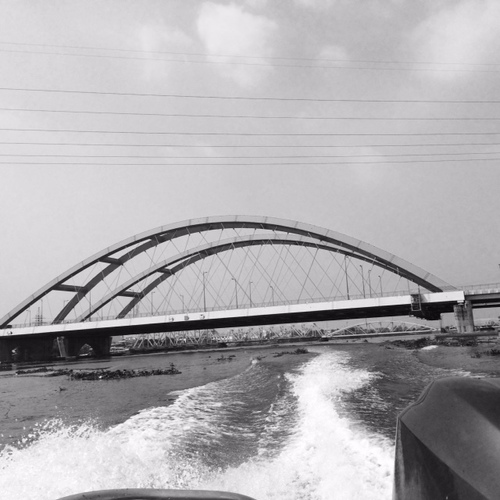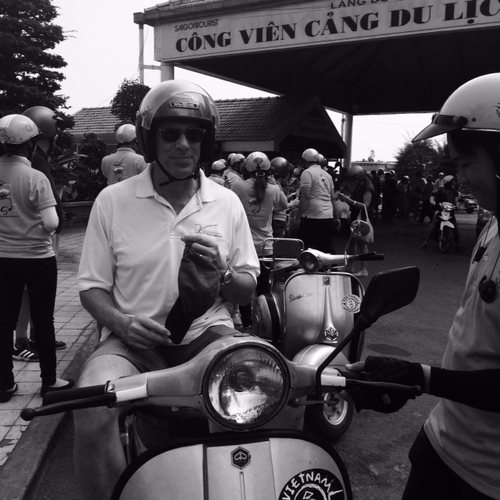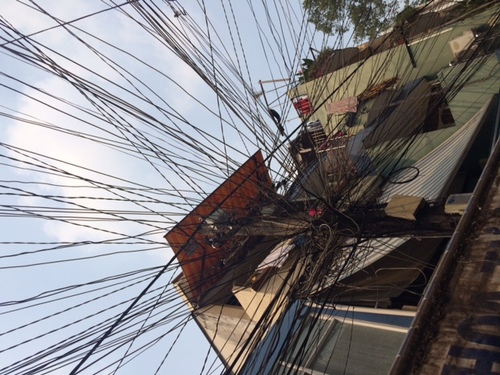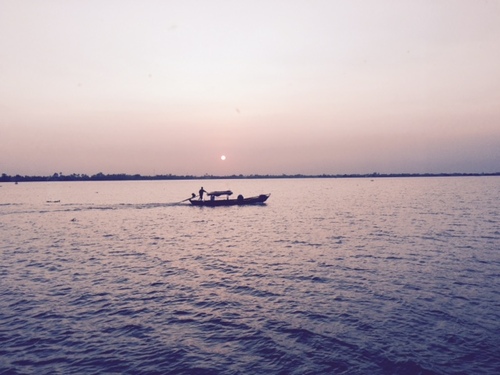MEKONG DELTA, VIETNAM - Please indulge me with this little bastardization of the late, great Robin Williams's signature phrase. Yes we are talking about Vietnam, which has evolved into a sexy place to go for adventure tourism. It offers abundant natural beauty, year-round mild to hot climate, and a vibrant, growing economy. It is at once exotic, yet an anachronism. It is extremely youthful, as a whopping 70 percent of the citizens are under 40.
From the green standpoint, imagine every stereotype of your perception of Asia at its best, and most chaotic. Delectable natural and organic fruits and vegetables, abundant reuse of building materials and furniture, densely populated cities yet an enormous polluter filled with unmuffled, antiquated vehicles of all shapes and sizes. A contradiction in terms, but fascinating nonetheless. And did I mention that the food is terrific? Welcome to Vietnam in the new millennium.

Bridges like this punctuate the periphery of Saigon showing that Vietnam takes their infrastructure seriously.
Saigon (now known officially as Ho Chi Minh City) is everything you would expect, and more. A true Asian megacity of 8 million, sprawling in all directions for 2095 square kilometers. Throw in six million motorbikes - the coolest ride you can have is a vintage series Vespa - and the term "organized chaos" is an accurate if not charitable description. Yet somehow it all works. The French influence can be seen and experienced through architecture, food and wine. Ethnic restaurants of all descriptions are everywhere. Buddhist temples are in abundance (70% practice Buddhism or variations thereof). Not surprisingly, there are remnants and reminders of the Vietnam War throughout. The Independence Palace, site of the Liberation Army's takeover of the country in 1975, has been restored and is a popular tourist venue. Another example is my experience at the atelier shopping boutique "Mai" which is run by noted designer Mai Lam. As a fan of "military look" I was immediately taken with her vintage U.S. Army flak jackets, embellished with silks and embroideries highlighting actual bullet holes. Mai explained that it was therapeutic to design these items as a beautiful memory of her brother, who was killed in the war.

Instead of being a spectator of the organized chaos, we tested our weaving and dodging skills on vintage Vespas in the heart of Saigon.jpg
This, however, is not a travel story about Saigon. For our purposes, we head north aboard the luxury sustainable houseboat (really a floating boutique hotel) Aqua Mekong, to explore what Vietnamese farm and village life looks like along the famous Mekong Delta. We find ourselves here through the special efforts of Miami residents Howard and Andrea Kaplan, members of a chief executives organization who have painstakingly organized this boating, hiking, biking tour for 40 of their colleagues to explore the culture, history and geography of the country. Engineered down to the smallest logistical detail, we are thus free to focus upon the people of Vietnam, how they live, and consider what the future holds for this mesmerizing, endearing country.
Not unlike the Mississippi River, the Mekong is wide and muddy, with a strong current that seems to flow in multiple directions. It is also nearly 100 feet deep in many places. One thing us residents of the Southwestern U.S. notice instantly is green. How invigorating to see a geography where it really rains! Lush foliage and wild grasses in all directions, especially now as the rainy season recently ended. River traffic is primarily barges pushing loads of dirt, gravel and other construction equipment and materials, interspersed with dilapidated but functional wooden vessels that resemble "Chinese junks." Much of the land along the river is completely under water during the rainy season, which makes for extremely fertile soil. A lucrative business is dredging soil from the river basin and shipping it by barge to Singapore, which pays handsomely for this fertile dirt. Hundreds of the junks, filled with whatever agricultural yield the owner is bringing to the floating marketplace, float by nonstop. Everything from guavas, turnips, potatoes and watermelons to chickens, various meats, vegetables and of course, lots and lots of rice. Be careful under power at night because some of them have no lights! Insanity, but hey, it's Asia...?
This is a country of 91 million people, and about 65 million of them live in the hundreds of small villages and towns that dot the countryside and shoreline. Most have populations from two to twenty thousand, and the centerpiece of each is the marketplace. Some marketplaces are on the water, otherwise known as "floating markets" while others are in the center of town. We have seen them before in Hollywood chase scenes such as Lara Croft: Tomb Raider; Hangover II, and Paradise Lost. Very narrow aisles, motorbikes and bicycles laden with fresh goods trying to negotiate these "streets" amidst scores of sellers and buyers. A seemingly endless array of things to eat, some appetizing and others not (uh, how about the cattle head with the bulging eye that seemed to stare me down, or the live snake soup, or the still-wriggling catfish and tilapia? Or the "farm-to-table" practice of selecting your own live chicken or goose and watching while it is beheaded before your very eyes?). The fresh croissants and breads are among the best in the world as recipe and technique were handed down by the French. Fresh fruit juices, and all manner of rice of course...be it white, brown, puffed, polished, crisped or boiled. Truly a visual smorgasbord of color, aroma, texture and flavor. As for prices, inexpensive is the word. Most of these agricultural-based farmer-vendors earn about $6-7,000 per year, which for Vietnam is a perfectly livable wage, probably analogous to about $35-50,000 per year in America.
Another word about food: probably not a great idea to eat the farm-raised fish from this part of the world. We saw first-hand what these look like, and it ain't pretty. Small cages, teeming with tilapia, throw in a large dose of hormones to promote size growth...and keep them there. No larger cages, no significant water flow through the waste (because this makes it easier and more efficient to feed them). From what we understand, some or all of this fish is heavily exported.
To digress just a bit, we saw up close and personal the lifestyle of these remarkably open and friendly people, who surprisingly are not hostile toward Americans. In fact, they seem to understand that the rise in tourism is good for their economy and thus welcomed us. As a sustainability fanatic, I had to analyze their lives from that standpoint. The verdict is decidedly mixed. On one hand, they do a much better job than we do of efficiently using food supplies, natural resources and worldly goods. As China is known for, hardly anything goes to waste. I need not give the gory details here but I think you understand where I am going. (No, they do not eat dogs or cats, thankfully. However, a delicacy is specially prepared rat, but only rats that are raised amidst the rice patties qualify.) Take the lowly coconut - after extracting the meat and the juice, the remaining materials are used for basket-making, fuel oil and mulch. Same goes for wood, tile, stone and other building materials. They are used, re-used, repaired and thus you don't see many landfills here.
Motor vehicles and furniture usually survive far, far beyond what would be their useful life in the U.S. However, there are virtually zero pollution controls on the various motors, engines and light manufacturing facilities, all of which routinely belch black smoke that pollutes more carbon per hour than 10,000 modern automobiles in the U.S. or Europe. Getting these simple people to practice sustainability is unrealistic at best. So, the only chance would be for the government to educate, enforce and supply the population with emissions controls, mufflers, and other ways to reduce carbon emissions.
Please understand, this is not extreme poverty. From the villagers we met and homes we saw, the Vietnamese people live modestly with few creature comforts, but have roofs over their heads, electricity, plenty of food to eat, and the family units seem to function well over generations. The young care for their elderly, and the elderly leave whatever legacy they can to their offspring. Health care is available although sometimes a good distance away, main roads are mostly paved asphalt, and the standard of living seems to be improving at a decent clip. Bear in mind that Vietnam's official name is "the Socialist Republic of Vietnam" and the government follows a unique philosophy of communism with a capitalist twist.
Business opportunities for foreign investors are actually quite favorable here. Walter Blocker, a successful American businessman who is based in Saigon and heads Vietnam Trade Alliance says that direct foreign investment in Vietnam has increased by a factor of 10 from $5 billion in 2005 to over $50 billion in 2007 and about $25B in 2014. The Vietnamese work force is highly skilled and has a tremendous work ethic. As a result, explains Blocker, many precision light manufacturing operations such as makers of smart phones, leather goods and high end clothing brands, among others, have invested major money in large factories here. Last year Vietnam was the largest exporter to the U.S. from Southeast Asia with total exports exceeding $30B.
A burning issue for this otherwise on-the-rise country is this: like others including China, the millennial generation shows a dramatic preference for moving out of the villages and into the cities of Saigon, Hanoi, Danang, and Can Tho. Thus given the huge percentage of younger population, what will become of the agrarian lifestyle and the villages themselves one or two generations from now? And, how will the already giant city of Saigon absorb what could be a doubling of its population within that timeframe? How will the government deal with this shift, and the increasing need to clean up the air in its cities? As the saying goes, only time will tell.
Until then, I recommend that if you are an Asia fan, do not miss the opportunity to visit Vietnam. Just one little warning: be careful when eating the peppers, especially the tiny green ones that look like jalapenos. They are the hottest, most concentrated little devils and will absolutely light you up like a firecracker if you accidentally swallow one.


